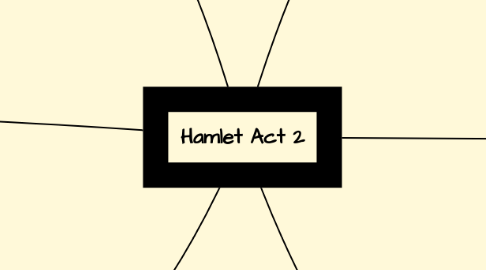
1. Breaking The Fourth Wall
1.1. The fourth wall is a conceptual barrier between those presenting some kind of a communication and those receiving it.
1.1.1. Breaking the fourth wall means doing or saying something that either explicitly or implicitly acknowledges the artificiality of the environment and the fact that both the presenters and audience are aware of that artificiality.
1.1.1.1. Example
2. Characters
2.1. Scene 1
2.1.1. Polonius
2.1.2. Claudius
2.1.3. Ophelia
2.1.4. Reynaldo
2.2. Scene 2
2.2.1. Claudius
2.2.2. Polonius
2.2.3. Rosencrantz
2.2.4. Guildenstern
3. Theme
3.1. Deception
3.1.1. Scene 1
3.1.1.1. We find Hamlet playing his "madness" ruse on the unsuspecting Ophelia.
3.1.2. Scene 2
3.1.2.1. The "king" sends Rosencratz and Guildenstern, two former friends of the prince, to spy on him to see if his madness is real.
3.1.2.2. Hamlet sets up the play in a thinly veiled attempt to deceive Claudius into confession, for the play reflects the usurper's crimes.
4. Plot
4.1. Scene 1
4.1.1. Polonius sends servants to spy on his son (Laertes).
4.1.2. Reynaldo has to find out what the “Danes are in Paris”.
4.1.3. Ophelia talks to her dad (Polonius) about how Hamlet is acting.
4.2. Scene 2
4.2.1. The King and Queen (Claudius and Gertrude) welcome Hamlet’s friends they invited to cheer him up.
4.2.2. The ambassadors sent to Norway return. Where Fortinbras tried to start a war on Denmark. The king (Claudius) disapproved and encouraged them to attack Poland.
4.2.3. Polonius presents a plan to spy on Hamlet and Ophelia to see if Hamlet is lovesick.
4.2.4. Hamlet announces that he will write the short speech to go with the play The Murder of Gonzago.
4.2.5. Hamlet decides that he will make the king (Claudius) watch the play to see if he has any signs of guilt.
5. Fun Facts
5.1. In Elizabethan times, the marriage of a widow to her brother-in-law was considered incestuous.
5.2. The castle in which the play is set really exists. It is called Kronborg castle and was built in the Danish port of Helsingør in 1420s by the Danish king, Eric of Pomerania.
5.3. Where now we say ‘I’m going to see a play’ in Elizabethan times, people talked about ‘going to hear a play’.
5.4. Poor people called the groundlings, or penny knaves, were famous their love of plays. They would pay one penny to stand in front of the stage in an area called the open yard.
5.5. In the 16th century, actors traveled from town to town on a cart, looking for audiences to pay to watch them perform. Playhouses were not constructed in London until 1576.
6. Literary Devices
6.1. Oxymoron
6.1.1. “Your bait of falsehood takes this carp of truth” - Polonius (II i 68)
6.2. Hyperbole/Simile
6.2.1. “And with a look so piteous in purport/ As if he had been loosed out of hell” - Ophelia (II i 90 - 91)
6.3. Situational Irony
6.3.1. “[Pointing to his head and shoulder.] Take this from this, if this be otherwise.” - Polonius (II ii 167-168)
6.4. Metaphor
6.4.1. “Denmark’s a prison” - Hamlet (II ii 285)
6.5. Personification
6.5.1. “Wherein I’ll catch the conscience of the King." - Hamlet (II ii 567)

